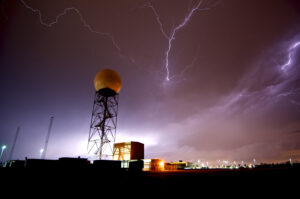Imagine a world without the vast, shimmering expanse of the oceans. This scenario seems lifted from the pages of science fiction. Oceans, covering more than 70% of our planet’s surface, are:
- The lifeblood of Earth.
- Supporting intricate ecosystems.
- Regulating climate.
- Providing essential resources for human survival.
But what if the oceans disappeared in a catastrophic turn of activities? Though improbable, this hypothetical situation demands us to keep in mind the significant ramifications for biodiversity, our atmosphere, climate styles, and human civilization.
The Earth’s weather could differ dramatically and unpredictably in the absence of oceans. Temperatures are moderated globally by means of the oceans’ function as a huge warmth sink, absorbing and moving solar strength. Temperature extremes are more substantial without this mechanism, resulting in sweltering days and icy nights. The loss of critical phenomena such as the Gulf Stream, El Niño, and monsoons, which depend on oceanic currents and interactions, might cause irreversible adjustments to climate patterns. These changes might have a devastating impact on agriculture, water delivery, and human habitation by inflicting severe droughts in a few regions and incessant storms in others.
The extinction of marine life and the vast meal webs that rely on it would also be the result of ocean loss. Millions of species may be found in oceans, many of which are essential to human industries like fishing and tourism, as well as the ecosystems in which they live. Among the most biodiverse ecosystems on Earth, coral reefs, kelp forests, and deep-sea vents might disappear, causing the lack of innumerable species. Since many land creatures rely on the ocean for food, either at once or not directly, the extinction of marine lifestyles might have a domino impact on terrestrial ecosystems.
The effects on the economy would also be terrible. Cities on the coast, which are home to billions of people and economic hubs, would face problems that have never been seen before. Fishing, shipping, and tourism are all industries that depend on the water. If they went away, there would be a lot of unemployment, and the economy would be unstable. Losing the seas would also mess up the global supply chain because a lot of goods are shipped by sea. This would lead to shortages and price increases around the world.
The loss of the oceans would have direct effects on the environment and the economy. It would also have a cultural and recreational impact on people. Throughout history, oceans have been a source of inspiration, fun, and spiritual meaning for many countries. If we lost this natural wonder, it would be missing from our cultural history and fun activities, making life less enjoyable for people all over the world.
The Science Behind Oceans
Mission Overview
To fully grasp the importance and complexity of Earth’s seas, one must first learn about where they came from, how they are now, and the important role they play in the planet’s life-support systems. Many scientific fields study the oceans, from geology and chemistry to biology and climatology. This section goes into more detail about the purpose of these fields. Scientists are trying to figure out how Earth’s oceans formed and how they have changed over billions of years. They also want to know how they continue to shape and support life on Earth today. This goal isn’t just about learning new things; it’s also about using what we learn to keep our oceans safe for future generations.
Formation and Evolution of Earth’s Oceans
Earth’s oceans have been around since the very beginning of the planet’s formation, about 4.5 billion years ago. Most scientists believe that water came to Earth through a mix of volcanic gas emissions and the impacts of comets and asteroids that were full of water. As the young Earth cooled, water vapor in the air condensed into liquid water. This water finally filled the Earth’s basins and made the first oceans.
Over thousands of years, these ancient seas went through big changes. The relationship between water and the crust of the Earth created complicated chemical processes that helped minerals form and important elements move around in the Earth. Continental shelves, mid-ocean ridges, and deep-sea trenches were all formed by plate tectonics, which was a major force in creating the ocean basins. Early life also grew in the seas. The first microorganisms were found in the hydrothermal vents on the ocean floor. Over time, these early forms of life changed and grew, creating the diverse range of sea life we see today.
Current Composition and Distribution of Oceans
These days, the oceans cover about 71% of the Earth’s area and hold about 97% of its water. The Pacific, Atlantic, Indian, Southern, and Arctic Oceans make up the five main oceans that make up the huge body of salt water. Every sea is different, but they all work together to keep the temperature and biosphere stable.
Seawater is mostly salty and is made up of dissolved salts, minerals, and different kinds of biological matter. Ocean water has an average salt of about 35 parts per thousand. However, this can be different in other areas because of things like evaporation, rainfall, river flow, and ice formation. The seas are divided into layers based on temperature and salinity. These layers make different habitats for many different kinds of marine life.

The location of the oceans affects the climate and weather trends around the world. Ocean currents move heat, nutrients, and gases around the globe like conveyor belts. They are caused by wind, the Earth’s spin, and differences in the density of the water. Temperatures are controlled by these currents, which affect weather patterns and climate. In the Atlantic Ocean, the Gulf Stream brings warm water from the tropics to the North Atlantic. This keeps the weather in Western Europe mild.
Immediate Consequences of Ocean Disappearance
The Sudden Loss: What Would Happen Initially?
The rapid disappearance of the oceans would have devastating and wide-ranging implications, affecting all aspects of life on Earth. Initially, a prominent consequence would be the revelation of the ocean floor, resulting in an instantaneous alteration of the planet’s topography. Enormous dust clouds would emerge when the formerly submerged seafloor becomes dry, resulting in extensive dust storms. These dust storms have the potential to obstruct sunlight, leading to a significant decrease in visibility and affecting weather patterns.
The coastal regions, home to billions of individuals, would encounter unparalleled difficulties. The abrupt cessation of water would lead to the collapse of economies dependent on the sea, making businesses such as fishing, shipping, and tourism immediately obsolete. Coastal cities would witness a substantial increase in mass migrations as individuals relocate to inland areas in pursuit of resources and livable land.
Furthermore, the disappearance of the oceans will disturb the worldwide distribution of potable water. A considerable proportion of the Earth’s freshwater supply is obtained from the sea via desalination facilities. In the absence of this essential resource, the scarcity of freshwater would quickly escalate into a crisis. Agriculture will be adversely affected since irrigation systems reliant on ocean-sourced water supplies would cease to function, resulting in food scarcity and heightened competition for the limited freshwater resources that remain.
Climate Catastrophe: Altered Weather Systems
The entire absence of the seas could provoke a climatic catastrophe, substantially modifying weather patterns globally. Oceans have an important feature in the regulation of the Earth’s weather through the absorption and redistribution of solar energy. Without the presence of this warmth sink, the planet’s temperature balance might be disrupted, leading to sizeable and unpredictable modifications in temperature.
An important alteration will be the cessation of ocean currents, which might be important for the worldwide distribution of warmth. For example, the Gulf Stream has the effect of heating Western Europe, resulting in an extremely greater temperate temperature in comparison to other regions positioned at similar latitudes. In the absence of these currents, areas reliant on those warming results would see substantial cooling, potentially ensuing in the onset of a new ice age in positive places. In evaluation, regions that depend upon the cooling have an impact on ocean currents and may additionally enjoy intolerably high temperatures.
The water cycle would also be significantly impacted. In the absence of oceans to facilitate the evaporation of water into the atmosphere, there would be significant alterations in rainfall patterns. Several areas may encounter severe droughts, while others could undergo unparalleled rains due to the scarcity of moisture, resulting in sudden floods and landslides. The disturbance of the hydrological cycle would have catastrophic effects on ecosystems, agriculture, and water resources.
Furthermore, the lack of seas would intensify the greenhouse impact. The oceans absorb around 30% of the carbon dioxide released into the atmosphere, assisting in the reduction of global warming. In the absence of this essential function, there would be a rapid increase in atmospheric CO2 levels, which would expedite climate change and result in more frequent and severe extreme weather events, such as hurricanes, heat waves, and severe storms.
To summarise, the immediate ramifications of ocean depletion would be catastrophic and far-reaching. The absence of the seas, caused by abrupt geographical and economic disruptions or gradual climate changes, would profoundly alter life on Earth, highlighting the crucial function they serve in maintaining the equilibrium and well-being of our planet.

Environmental Impacts
Disruption of Global Climate Regulation
If the oceans disappeared, it would be very hard to keep the world’s climate stable because the big bodies of water are so important to this process. Oceans are very important for absorbing and moving solar energy, keeping temperatures stable around the world. Without seas, Earth would not be able to control its temperature, which would cause temperature changes that are very big and not consistent.
The natural heat exchange system would break down, which is a big effect. Ocean currents take in heat from the sun and send it all over the world. Currents like the Gulf Stream and the Antarctic Circumpolar Current help keep the temperature stable by moving warm water to cooler areas and cold water to warmer regions. Without these currents, regional climates would become more extreme, with areas around the equator getting uncomfortably hot and regions around the poles getting colder.
The hydrological cycle would also be drastically changed since clouds and rain depend on marine evaporation. If there were no seas to bring in water, rain patterns would become random and uneven. Because there wouldn’t be much water vapor, some places would be hit by serious droughts, while others might get too much rain, which could cause flash floods and soil erosion. This disruption would have big effects on farming, water supplies, and the ability of many areas to be lived in.
Desertification and Loss of Biodiversity
If the oceans went away, many regions could emerge as deserts, turning locations that have been once rich in flowers and animals into empty areas. The oceans are an important part of the hydrological cycle because they hold the land wet and help vegetation grow. Without the consistent delivery of water from ocean evaporation, many regions would dry out right away, which would cause deserts to grow and farmland to be lost.
It might have terrible results on species. There are many types of dwelling matters inside the oceans, from tiny plankton to large whales. A lot of species, such as many that might be crucial to world ecosystems, might become extinct if marine habitats disappear. Coral reefs, kelp forests, and deep-sea ecosystems would disappear, eliminating the houses of many aquatic species and frightening the food chains that depend on them.

Ecosystems on land might also be badly affected. A lot of animals that stay on land get their meals from the seas, both via consuming marine existence at once or circuitously through the meals internet. If these food sources dried up, the numbers of many land species could drop, which could make the arena even less diverse. Also, without the oceans to keep the weather in test, there might be more severe weather, which would place even extra pressure on terrestrial ecosystems and make it harder for species to stay and adapt.
Conclusion
The hypothetical oceans evaporating shows how vital these massive amounts of water are to Earth’s biological and climatic balance. Over 70% of Earth’s surface is ocean, which regulates temperatures, supports biodiversity, and sustains human life and economies.
Losing the oceans would change the planet’s landscape and cause mass migrations as coastal economies and freshwater supplies collapsed. The climatic catastrophe would destroy ocean currents, causing extreme temperature changes and weather patterns, changing the worldwide climate system.
Environmental damage would be permanent. Without the seas, global climate regulation would collapse, causing catastrophic weather. Desertification would destroy biodiversity and convert productive lands into dried wastelands. Marine species loss would affect terrestrial life and worsen ecological imbalance within the food web.
This scenario shows how important the oceans are to life and Earth’s ecology. It strongly emphasizes the necessity for sustainable ocean conservation. Our survival and the planet’s health depend on understanding and valuing the oceans. For present and future generations, we must preserve our oceans.
